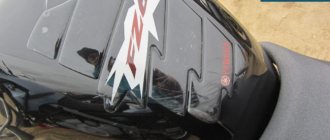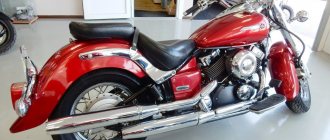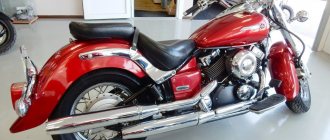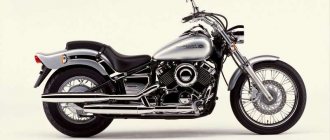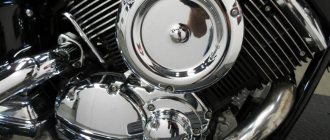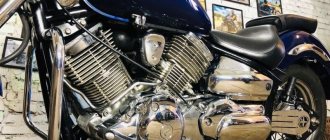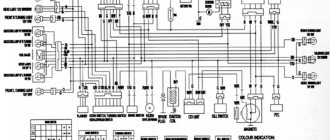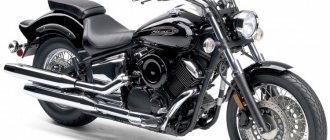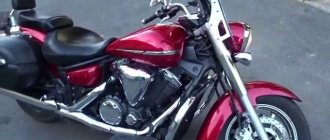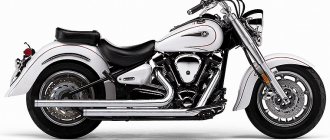Introduction
Page 3
- Image
- Text
Welcome to the world of Yamaha motorcycles!
As the owner of an XVS650/XVS650A motorcycle, you have the opportunity to benefit from Yamaha's vast experience and the latest technology in the development and manufacture of high-quality products that give Yamaha a reputation for reliability.
Please take the time to read this manual carefully to ensure that you get the full benefit of your XVS650/XVS650A motorcycle. This Owner's Manual will not only provide you with instructions for operating, inspecting and maintaining your motorcycle, but will also teach you how to avoid trouble or injury to yourself and others.
In addition, the tips provided in this manual will help you always keep your motorcycle in the best condition. If you have any questions, please do not hesitate to contact your Yamaha dealer.
At Yamaha, we wish you many safe and enjoyable travels. So, remember about safety!
EAU03338
INTRODUCTION
5SC-28197-R0-0.pmd
2003/05/22, 15:04
1
Comments • 18
Everything is fine, only the manual states that the crankshaft needs to be turned clockwise, not counterclockwise.
Greetings, hmm.. I need to clarify this point, thank you.
Why remove the tensioner if you can see that the marks are perfect. It would be better to say what mileage. so that the people know the flattery there or not.
Well, probably not everyone can determine by eye the angle of deflection of the chain in degrees, for me it’s easier, I expressed my point of view :))
Turn the crankshaft counterclockwise?
Yes, counterclockwise, here in my opinion there is another important point, if you turned the mark a little, you shouldn’t turn it back a little, there is a decent amount of play on the chain, I turned it a quarter back and caught the mark again.
It would be interesting to see about Valera’s decarbonization))
Source
IMPORTANT INFORMATION IN THIS MANUAL Particularly important information...
Page 4
- Image
- Text
EAU00005
IMPORTANT INFORMATION IN THIS MANUAL
Particularly important information in this manual is identified as follows:
The safety symbol means: WARNING! BE CAREFUL ! THIS IS ABOUT YOUR SAFETY!
Failure to follow the WARNING instructions may result in serious injury or death to the motorcycle operator, bystanders, or anyone inspecting or repairing the motorcycle.
A CAUTION indicates special precautions that must be taken to prevent damage to the motorcycle.
NOTE:
The NOTE heading contains information to make operations easier or clearer.
NOTE:
8
This Manual should be considered an integral part of the motorcycle and should remain with it even if it is subsequently sold.
8
Yamaha is constantly introducing improvements to the design of the motorcycle and improving the quality of its products. Therefore, although this Manual contains the latest product information available at the time of printing, your motorcycle may differ slightly from the descriptions in this Manual. If you have any questions regarding this manual, please contact your Yamaha dealer.
Q
5SC-28197-R0-0.pmd
2003/05/22, 15:04
2
Technical characteristics of the Yamaha Drag Star 400 (XVS 400) motorcycle
It’s worth starting with the weight and size characteristics. Thanks to the layout of a classic cruiser with a low center of mass, even a loaded version of the motorcycle weighing under 250 kilograms is quite acceptable for weak female hands in a static position. When it comes to maneuvering on the move, if there are any complaints to be made, they tend to apply to the entire cruiser class. Lifting the bike by yourself is easy thanks to its low center of mass.
| Drag Star 400 (1996 – 1999) | Drag Star 400 (2000 – 2009) | Drag Star 400 (2010 – 2017) | Drag Star 400 Classic (1996 – 1999) | Drag Star 400 Classic (2000 – 2009) | Drag Star 400 Classic (2010 – 2017) | |
| Dry weight (kg) | 204 | 209 | 218 | 222 | 224 | 231 |
| Curb weight (kg) | 220 | 225 | 234 | 238 | 240 | 247 |
| Length (mm) | 2340 | 2450 | ||||
| Width (mm) | 845 | 840 | 930 | |||
| Height (mm) | 1045 | 1060 | 1065 | 1105 | 1110 | |
| Seat height (mm) | 660 | 710 | ||||
| Wheelbase (mm) | 1610 | 1625 | ||||
| Front tire size | 100/90-19M/C 57S | 130/90-16M/C 67S | ||||
| Rear tire size | 170/80-15M/C 77S | |||||
| Ground clearance (mm) | 140 | 145 | ||||
| Frame | Steel duplex | |||||
Weight and dimensions characteristics of motorcycles Yamaha Drag Star 400 (XVS 400)
The weight of the “Draga” allows you to feel confident on the road – neither passing oncoming heavy vehicles nor side winds cause any particular discomfort. But, unfortunately, not everything is so perfect. The XVS 400 is equipped with an engine with a displacement of 400 cubic centimeters, and its capabilities are clearly not enough even for overtaking vehicles on certain high-speed sections of the highway. In the city, the dynamics will be at the level of most small cars; high-speed runs from traffic light to traffic light will have to be abandoned. However, the cruiser class itself does not provide for such operation of equipment. In other words, leisurely trips for your own pleasure - that’s what the Drag Star 400 is all about. If we talk about traffic jams, then two features need to be taken into account. The first is an air-cooled engine, so crawling along with everyone else is of course possible, but not recommended. The second is the width of the handlebars, which will not allow you to squeeze into every gap formed, which is perhaps for the best, especially for those who purchase the Drag Star as their first motorcycle.
| Drag Star 400, Drag Star 400 Classic (1996-2009) | Drag Star 400, Drag Star 400 Classic (2010-2017) | |
| Engine | Four-stroke, two-cylinder, V-shaped, air cooled | |
| Working volume | 399 cubic centimeters | |
| Bore diameter/piston stroke | 68/55 millimeters | |
| Compression ratio | 9,7:1 | |
| Gas distribution mechanism | 2 valves per cylinder, single camshaft (SOHC) | |
| Fuel supply | Carburetors 2x Mikuni BDS28 | Injector |
| Ignition | Transistor-coil (TCI) | |
| Engine power | 33 l. With. at 7500 rpm | 30 l. With. at 7500 rpm |
| Torque | 32 Nm at 6000 rpm | 31 Nm at 6250 rpm |
| Acceleration to 100 km/h (according to the manufacturer) | 11.2 seconds | |
| Maximum speed (according to manufacturer) * | 135 km/h | |
| Fuel consumption (according to manufacturer)** | 2.28 liters per 100 km | 2.63 liters per 100 km |
| Fuel tank volume | 15 liters | |
| Transmission | Five-speed | |
| Clutch | Multi-disc in oil bath with cable drive | |
| Wheel drive | Cardan shaft | |
| Front suspension | Telescopic fork with 140 mm travel | |
| Rear suspension | Progressive pendulum with monoshock absorber with preload adjustment with a stroke of 86 millimeters | |
| Front brake | Single disc, 298 mm disc, two-piston caliper | |
| Rear brake | Drum | |
* Quite achievable speed, but it will take a relatively long time to accelerate ** A spherical value in a vacuum, which is not worth looking at at all. The Japanese say that such consumption is achieved at a constant speed of 60 km/h with a passenger, there is no reason not to believe them, but you can and should doubt it.
Separately, you need to pay attention to the wheels. As is not difficult to notice, they are wired, which means there is a camera inside (hello, captain). This decision is due to the same desire to achieve similarity with old motorcycles, and not for additional depreciation. The advantage of this is that an unfortunate cut of asphalt will be transferred with less consequences, but the disadvantage is that repairing a punctured wheel will take a lot of time.
Controversial decisions in the design include the cardan shaft. On the one hand, it deprives the owner of all the delights of caring for the chain. On the other hand, it increases the mass and also has a lower efficiency when transmitting rotational motion to the wheel, which, with an engine with not the highest power, can be attributed to negative aspects.
There is a lot of controversy around the braking capabilities of the Yamaha Drag Star 400. The fact is that the “Drag” 400 has a larger mass than most competitors, and accordingly it is more difficult to stop this mass. In addition, rear wheel braking is carried out using a drum brake, which is usually not serviced in a timely manner. But do not forget that the XVS 400 has very mediocre acceleration dynamics, therefore, in order to start experiencing problems when braking, you must first accelerate the motorcycle. One thing is superimposed on the other and the bottom line is that the brakes installed on the XVS 400 are quite sufficient. In addition, no one bothers you to install “softer” pads.
Important information about this manual
Page 5
- Image
- Text
IMPORTANT INFORMATION ABOUT THIS MANUAL
EW000002
PLEASE READ THIS MANUAL CAREFULLY BEFORE OPERATING THIS MOTORCYCLE.
5SC-28197-R0-0.pmd
2003/05/22, 15:04
3
Valve clearances for Yamaha Drag Star 1100 according to the manual
Sanchez » 05 Aug 2014, 15:39
The moped is not mine (c) The authorship of the text and photo below belongs to the members of the VKontakte group on Dragstars, she is the only one there.
So. Go. The dots correspond to the numbers of the pictures. 1. Remove the passenger and driver seats.
2. Open the plastic cover on which the electronic unit is located, disconnect the wire connector going to the tank, turn off the gas tap, remove the hose from the tap and remove the gas tank itself.
3. Remove the air filter.
4. Remove the air distribution box, the one under the tank, remove the pipes going to the carbs, plug the carbs with clean rags.
5. Unscrew the two plugs on the left cover. those that are large are for a screwdriver.
6. Remove the plastic decorative cover on the cylinder heads (two bolts). Remove the sprocket cover (two bolts). We insert a 22mm socket into the large hole on the left cover and turn the crankshaft clockwise until the mark on the gear is approximately opposite the tooth on the body. We see this. Shine a flashlight into the second window on the left cover and align the marks. For the front cylinder I have just a mark, and for the rear mark with the letter T. In any case, the mark on the sprocket should be opposite the tooth. The valves are closed in this position.
7. Remove the access cover to the inlet valve.
8. Hexagon, 12 key and feeler gauge. For the intake, the clearance is 0.07. For graduation 0.12. Loosen the lock nut, adjust the gap, tighten the lock nut.
9. Same for the exhaust valve.
Then we move on to the rear cylinder. We repeat points 6,7,8,9.
Source
Valve clearances for Yamaha Drag Star 1100 according to the manual
Ringing (rattling) in the rear cylinder on Drage 1100
Post by Chita » May 24, 2010, 11:34 am
Gentlemen, how does the engine work on the drag?
I noticed the following trouble: when cold, the engine runs quietly, but as it warms up, a quiet ringing is heard in the rear boiler (a rattling, chattering sound, I don’t know how to explain) and as the speed/temperature increases after the trip, it becomes louder. It doesn't look like a valve, because... I can't hear it when it's cold. Maybe a timing chain?
In general, this is my first air vent, so maybe I’m being picky - everyone says that they are noisier than dropsy.
Re: Ringing (rattling) in the rear cylinder on Drage 1100
Post by Denis » May 24, 2010, 01:58 pm
Chita wrote: Gentlemen, how does the drag engine work?
I noticed the following trouble: when cold, the engine runs quietly, but as it warms up, a quiet ringing is heard in the rear boiler (a rattling, chattering sound, I don’t know how to explain) and as the speed/temperature increases after the trip, it becomes louder. It doesn't look like a valve, because... I can't hear it when it's cold. Maybe a timing chain?
In general, this is my first air vent, so maybe I’m being picky - everyone says that they are noisier than dropsy.
Re: Ringing (rattling) in the rear cylinder on Drage 1100
Post by Chita » May 24, 2010, 2:17 pm
Re: Ringing (rattling) in the rear cylinder on Drage 1100
Post by Charlie » May 24, 2010 02:26 pm
Re: Ringing (rattling) in the rear cylinder on Drage 1100
Post by Denis » May 24, 2010, 2:34 pm
Re: Ringing (rattling) in the rear cylinder on Drage 1100
Post by Pedro » 24 May 2010, 15:28
Re: Ringing (rattling) in the rear cylinder on Drage 1100
Post by Chita » May 24, 2010, 04:49 pm
Re: Ringing (rattling) in the rear cylinder on Drage 1100
Post by Pedro » May 24, 2010, 05:21 pm

